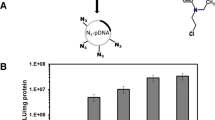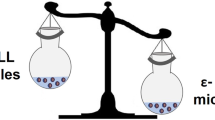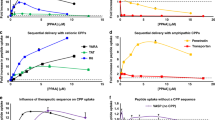Abstract
We have synthesized a hydrophilic cationic homopolymer of N-trimethylammonium ethyl methacrylate chloride (pTMAEM) and its copolymers with 1-vinyl-2-pyrrolidone (VP) and methyl methacrylate (MMA) at various monomer ratios and examined the physicochemical and biological characteristics of polymer/DNA complexes. All the (co)polymers were able to condense DNA to small particles and protect it from nuclease degradation. The particle size of pTMAEM/DNA complexes was smaller (550–175 nm) than the other polymers (1200–300 nm) tested. The zeta potential of the complexes was increased with increasing (co)polymer/DNA weight ratios and reached the constant value. The plateau value slightly decreased from +28 mV to +21 mV (P > 0.05) when the monomer content was increased. The optimal transfection efficiency of pTMAEM/DNA (655 mU/mg protein) was found at 0.5 polymer/DNA weight ratio and was reduced with increasing weight ratios due to increased cytotoxicity. The maximum transfection efficiency of copolymer/DNA was observed at a weight ratio of one and transfection efficiency slightly decreased with increasing monomer content in the copolymers. Overall, pTMAEM-VP/DNA complexes showed reduced cytotoxicity and increased transfection efficiency as compared with the other (co)polymers tested.
This is a preview of subscription content, access via your institution
Access options
Subscribe to this journal
Receive 12 print issues and online access
$259.00 per year
only $21.58 per issue
Buy this article
- Purchase on Springer Link
- Instant access to full article PDF
Prices may be subject to local taxes which are calculated during checkout







Similar content being viewed by others
References
Friedmann T . Progress toward human gene therapy Science 1989 244: 1275–1281
Smith AE . Viral vectors in gene therapy Annu Rev Microbiol 1995 49: 807–838
Davis SS . Biomedical applications of nanotechnology – implications for drug targeting and gene therapy Trends Biotechnol 1997 15: 217–224
Felgner PL . Nonviral strategies for gene therapy Sci Am 1997 276: 102–106
Ledley FD . Nonviral gene therapy: the promise of genes as pharmaceutical products Hum Gene Ther Rev 1995 6: 1129–1144
Kircheis R, Kichler A, Wallner G . Coupling of cell-binding ligands to polyethylenimine for targeted gene delivery Gene Therapy 1997 4: 409–418
Vitiello L, Chonn A, Worton RG . Condensation of plasmid DNA with polylysine improves liposome-mediated gene transfer into established and primary muscle cells Gene Therapy 1996 3: 396–404
Wetering P, Schuurmans-Nieuwenbroek NME, Hennink WE . Copolymers of 2-(dimethylamino)ethyl methacrylate with ethoxytriethylene glycol methacrylate or N-vinyl-pyrrolidone as gene transfer agents J Control Rel 2000 64: 193–203
Wolfert MA et al. Characterization of vectors for gene therapy formed by self-assembly of DNA with synthetic block co-polymers Hum Gene Ther 1996 7: 2123–2133
Mahato RI, Takakura Y, Hashida M . Nonviral vectors for in vivo gene delivery: physicochemical and pharmacokinetic considerations Crit Rev Ther Drug Carrier Syst 1997 14: 133–172
Plank C, Tang MX, Wolfe AR, Szoka FC Jr . Branched cationic peptides for gene delivery: role of type and number of cationic residues in formation and in vitro activity of DNA polyplexes Hum Gene Ther 1999 10: 319–332
Toncheva V et al. Novel vectors for gene delivery formed by self-assembly of DNA with poly(L-lysine) grafted with hydrophilic polymers Biochim Biophys Acta 1998 1380: 354–368
Katayose S, Kataoka K . Water-soluble polyion complex associates of DNA and poly(ethylene glycol)-poly(L-lysine) block copolymer Bioconj Chem 1997 8: 702–707
Katayose S, Kataoka K . Water-soluble polyion complex associates of DNA and poly(ethylene glycol)-poly(L-lysine) block copolymer Ogris M. DNA/polyethylenimine transfection particles: influence of ligands, polymer size, and PEGylation on internalization and gene expression. AAPS PharmSci 2001; 3 (3): E21.
Kwoh DY et al. Stabilization of poly-L-lysine/DNA polyplexes for in vivo gene delivery to the liver Biochim Biophys Acta 1999 1444: 171–190
Ciftci K, Levy RJ . Enhanced plasmid DNA transfection with lysosomotropic agents in cultured fibroblasts Int J Pharm 2001 218: 81–92
Oupicky D et al. DNA delivery system based on complexes of DNA with synthetic polycations and their copolymers J Control Rel 2000 65: 149–171
Hoffmann F et al. Preparation, characterization and cytotoxocity of ethylmethacrylate copolymer nanoparticles with a permanent positive surface charge Int J Pharm 1997 157: 189–198
Mosmann T . Rapid colorimetric assay for cellular growth and survival: application to proliferation and cytotoxicity assays J Immunol Meth 1983 65: 55–63
Bradford MM . A rapid and sensitive method for the quantification of microgram quantities of protein utilizing the principle of protein-dye binding Anal Biochem 1976 72: 248–254
Author information
Authors and Affiliations
Rights and permissions
About this article
Cite this article
Su, J., Kim, CJ. & Ciftci, K. Characterization of poly((N-trimethylammonium) ethyl methacrylate)-based gene delivery systems. Gene Ther 9, 1031–1036 (2002). https://doi.org/10.1038/sj.gt.3301770
Received:
Accepted:
Published:
Issue Date:
DOI: https://doi.org/10.1038/sj.gt.3301770



